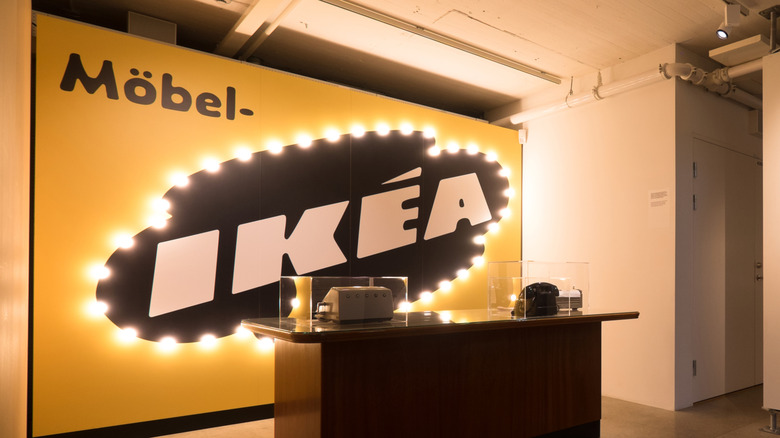What Does IKEA Really Stand For?
Most people know IKEA as the blue-and-yellow warehouse where you can snag minimalist furniture and meatballs under the same roof. But behind the name is a story rooted in rural Sweden, told through an acronym that reflects the company's founding values. IKEA stands for "Ingvar Kamprad Elmtaryd Agunnaryd," a mash-up of the founder's initials, the name of his family's farm, and the close-by village. Ingvar Kamprad, just 17 at the time, launched IKEA in 1943 as a small mail-order business.
Initially, Kamprad sold everyday items like pens and wallets to neighbors in the region of Småland, a rugged area known for resourcefulness and thrift. That sense of making do with what you have is a cultural hallmark of Småland, a place touted by the official Visit Sweden tourism site as "as Swedish as it gets," and this wound up shaping IKEA's entire brand ethos. The company's early catalog model was born of necessity (the rural location made it nearly impossible for urban customers to access IKEA's products), and its emphasis on functional design at low cost was a direct extension of the region's frugal practicality. Even the brand's flat-pack innovation, which changed the furniture industry forever, was born from a desire to minimize shipping costs and reduce damage during transport.
As IKEA grew from a rural mail-order business to a worldwide retail powerhouse, its name never lost its connection to Småland. The brand's expansion into furniture marked the start of an entirely new approach to how people furnished their homes. With clean lines, compact storage solutions, and low-cost materials, the IKEA name has long represented a design aesthetic that resonates far beyond Sweden's borders.
How a Swedish acronym became a global brand identity
Today, IKEA is a household name in more than 60 countries. While the letters I-K-E-A may seem like nothing more than branding shorthand, they continue to carry the DNA of a company built on DIY spirit and democratic design ideals. This, along with its balance of affordability and aesthetics, has helped the store win praise from professional designers who are happy to share items they actually buy at IKEA.
Central to IKEA's global appeal is a deeply rooted Småland concept known as lista, a pragmatic cleverness born from necessity that prizes inventive solutions over flashy aesthetics. In a region marked by rocky soil and limited resources, making do with what was available wasn't just virtuous, it was essential. This ethos shaped IKEA's innovative business model: By asking customers to assemble furniture themselves, the company not only reduced costs but also transformed home furnishing into a shared creative endeavor.
This interactive model gave rise to what's now known as the IKEA effect — a psychological phenomenon where people value products more highly when they've contributed to their creation. Assembly, rather than being a chore, became integral to the brand's appeal, reinforcing IKEA's message of empowerment through simplicity. Arguably, the IKEA effect theory has changed people's view of interior design.
That ethos sparked a broader movement. IKEA's products turned into canvases for DIY enthusiasts and interior tinkerers, who saw potential in every flat pack. From practical customizations using overlays to elaborate hacks, the brand's modular designs invited reinterpretation, turning everyday shoppers into active participants in the design process.
From logotypes to legacy — the name that built a global brand
Though IKEA's name has remained constant, its visual identity has significantly evolved since the company's founding. Early logos were meant to inspire local trust, sometimes including accents, decorative elements, or the name of the nearby railway stop. In the 1950s and '60s, as IKEA professionalized, it adopted standardized typography and bold, clear graphics. The iconic blue-and-yellow color scheme, which has been consistently in use since 1983, pays homage to the Swedish flag.
Today, IKEA stores welcome nearly 900 million visitors annually across the globe. Its website alone attracts over four billion visits each year. Despite its vast global reach, the brand retains distinctly Swedish touches, such as naming sofas after towns in Sweden. These playful naming conventions serve as cultural nods that point to deeper personal roots — this practical solution helped Kamprad, who had dyslexia, easily identify and manage inventory.
IKEA's name now signifies far more than just its founder or Swedish practicality. It represents an entire philosophy centered around affordability, flexibility, and thoughtful design. Whether customers are turning IKEA wardrobes into built-ins for entryway storage or exploring showroom layouts resembling compact city apartments, the brand remains deeply anchored in user-focused innovation. This ongoing evolution — evident in its changing logos, expanding global presence, and community-driven design approach — has seen to it that the IKEA name remains not only intact but also iconic, a rare, if not also wonderful, feat in today's globalized world.


